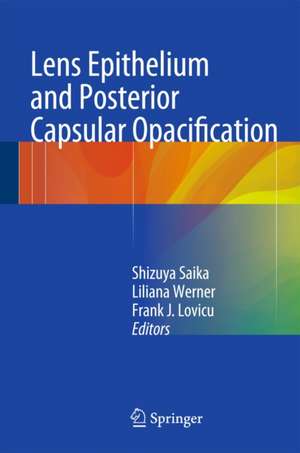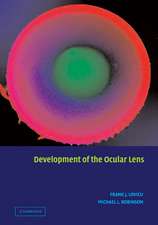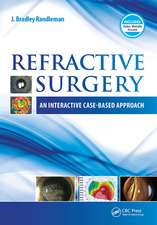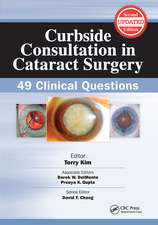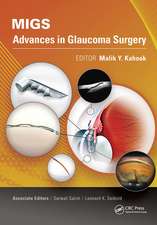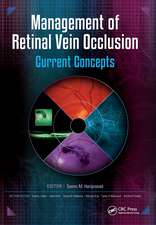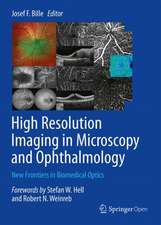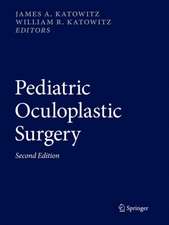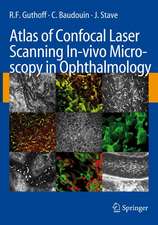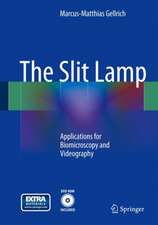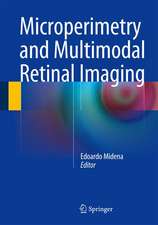Lens Epithelium and Posterior Capsular Opacification
Editat de Shizuya Saika, Liliana Werner, Frank J. Lovicuen Limba Engleză Hardback – 26 aug 2014
The first section of the text explains the molecular mechanism and biology of lens epithelial cells that lead to the incidence of PCO. In the second part, in addition to a description of the mechanism and pathological condition of PCO, surgical methods and devices for preventing PCO are discussed in detail. Lens Epithelium and Capsular Opacification will benefit not only young clinical residents and junior researchers, but also established faculty in the clinical or basic academic field.
| Toate formatele și edițiile | Preț | Express |
|---|---|---|
| Paperback (1) | 787.06 lei 38-44 zile | |
| Springer – 27 sep 2016 | 787.06 lei 38-44 zile | |
| Hardback (1) | 730.92 lei 6-8 săpt. | |
| Springer – 26 aug 2014 | 730.92 lei 6-8 săpt. |
Preț: 730.92 lei
Preț vechi: 769.39 lei
-5% Nou
Puncte Express: 1096
Preț estimativ în valută:
139.86€ • 146.04$ • 115.49£
139.86€ • 146.04$ • 115.49£
Carte tipărită la comandă
Livrare economică 15-29 aprilie
Preluare comenzi: 021 569.72.76
Specificații
ISBN-13: 9784431542995
ISBN-10: 443154299X
Pagini: 240
Ilustrații: XVII, 424 p. 175 illus., 140 illus. in color.
Dimensiuni: 155 x 235 x 25 mm
Greutate: 0.79 kg
Ediția:2014
Editura: Springer
Colecția Springer
Locul publicării:Tokyo, Japan
ISBN-10: 443154299X
Pagini: 240
Ilustrații: XVII, 424 p. 175 illus., 140 illus. in color.
Dimensiuni: 155 x 235 x 25 mm
Greutate: 0.79 kg
Ediția:2014
Editura: Springer
Colecția Springer
Locul publicării:Tokyo, Japan
Public țintă
Professional/practitionerCuprins
PART I: Lens Epithelial Cell Biology.- Chapter 1. From Zygote to Lens: Emergence of the Lens Epithelium.- Chapter 2. Cell Biology of Lens Epithelial Cells.- Chapter 3. The Lens Capsule – Synthesis, Remodeling and MMPs.- Chapter 4. Lens Epithelial Cell Proliferation.- Chapter 5. Growth Factor Signaling in Lens Fiber Differentiation.- Chapter 6. Lens-Specific Transcription Factors and Their Roles in Diagnosis and Treatment of Human Congenital Cataract.- Chapter 7. Lens Regeneration.- Chapter 8. Fibrotic Modifications of the Lens Epithelium.- Chapter 9. Wound Healing and Epithelial-Mesenchymal Transition in the Lens Epithelium: Roles of Growth Factors and Extracellular Matrix.- Part II: Clinical Science -Pathology.- Chapter 10. Histology of Posterior Capsular Opacification.- Chapter 11. PCO Rates in a Large Series of Human Eyes Obtained Post-Mortem.- Part III: Clinical Outcomes.- Chapter 12. Natural Course of Elschnig Pearl Formation and Disappearance.- Chapter 13. Effect of Posterior Capsule Opacification and Anterior Capsule Contraction on Visual Function.- PART IV: Surgical Methods for PCO Prevention.- Chapter 14. Size of Continuous Curvilinear Capsulorhexis for Prevention of PCO.- Chapter 15. Effect of Anterior Capsule Polishing on Capsule Opacification and YAG Laser Capsulotomy.- Chapter 16. Laser Photolysis System and PCO Prevention.- PART V: Intraocular Lenses/Devices and PCO.- Chapter 17. PCO Prevention: IOL Material Versus IOL Design.- Chapter 18. Capsular and Uveal Biocompatibility of Different IOLs in Eyes with and Without Associated Conditions.- Chapter 19. Capsule-Bending Ring for the Prevention of Posterior Capsule Opacification.- Chapter 20. PCO Prevention with Endocapsular Equator Rings.- Chapter 21. PCO Prevention with IOLs Maintaining an Open or Expanded Capsular Bag.- Chapter 22. Prevention of PCO with the Bag-in-the-lens (BIL).- Chapter 23. Posterior capsule Opacification with Micro incision (MICS) IOLs.- PART VI: Special Cases.- Chapter24. PCO and the Pediatric Eye.
Notă biografică
Shizuya Saika, M.D. , Ph.D.
Dr. Shizuya Saika is chairman/professor of the Department of Ophthalmology, Wakayama Medical University School of Medicine, Wakayama, Japan. Dr. Saika completed his M.D. in 1988 and his Ph.D. in 1993 from this university. He was also engaged in basic science research in the Department of Ophthalmology, University of Cincinnati School of Medicine, Ohio, USA, in 1998 –1999. He has been engaged in basic science research in wound healing of lens and cornea besides his clinical work, especially of surgeries for cataract, glaucoma and vitreoretinal disorders.
Liliana Werner, M.D., Ph.D.
Liliana Werner, M.D., Ph.D., is a tenured associate professor of ophthalmology and visual sciences and co-director of the Intermountain Ocular Research Center at the John A. Moran Eye Center, University of Utah, Salt Lake City, UT, USA. She has an M.D. degree from Brazil and a Ph.D. degree (biomaterials) from France. Dr. Werner’s research is centered on the interaction between ocular tissues and different intraocular lens designs, materials and surface modifications. These include intraocular lenses implanted after cataract surgery and also phakic lenses for refractive surgery as well as ophthalmic implantable devices in general.
Frank J. Lovicu, Ph.D.
Dr. Frank J. Lovicu is a professor in the School of Medical Sciences, in the Discipline of Anatomy and Histology, Bosch Institute and Save Sight Institute, at the University of Sydney, NSW, Australia. He currently heads the Lens Research Laboratory in Anatomy and Histology, where he primarily studies the role of growth factor signaling in regulating lens cell behavior. His research promotes the understanding of the cellular and molecular processes leading to normal lens development and growth, as well as those leading to cataract. His research findings have the potential for development of new strategies to treat and/orprevent cataract.
Dr. Shizuya Saika is chairman/professor of the Department of Ophthalmology, Wakayama Medical University School of Medicine, Wakayama, Japan. Dr. Saika completed his M.D. in 1988 and his Ph.D. in 1993 from this university. He was also engaged in basic science research in the Department of Ophthalmology, University of Cincinnati School of Medicine, Ohio, USA, in 1998 –1999. He has been engaged in basic science research in wound healing of lens and cornea besides his clinical work, especially of surgeries for cataract, glaucoma and vitreoretinal disorders.
Liliana Werner, M.D., Ph.D.
Liliana Werner, M.D., Ph.D., is a tenured associate professor of ophthalmology and visual sciences and co-director of the Intermountain Ocular Research Center at the John A. Moran Eye Center, University of Utah, Salt Lake City, UT, USA. She has an M.D. degree from Brazil and a Ph.D. degree (biomaterials) from France. Dr. Werner’s research is centered on the interaction between ocular tissues and different intraocular lens designs, materials and surface modifications. These include intraocular lenses implanted after cataract surgery and also phakic lenses for refractive surgery as well as ophthalmic implantable devices in general.
Frank J. Lovicu, Ph.D.
Dr. Frank J. Lovicu is a professor in the School of Medical Sciences, in the Discipline of Anatomy and Histology, Bosch Institute and Save Sight Institute, at the University of Sydney, NSW, Australia. He currently heads the Lens Research Laboratory in Anatomy and Histology, where he primarily studies the role of growth factor signaling in regulating lens cell behavior. His research promotes the understanding of the cellular and molecular processes leading to normal lens development and growth, as well as those leading to cataract. His research findings have the potential for development of new strategies to treat and/orprevent cataract.
Textul de pe ultima copertă
This book is the first to summarize the current knowledge of the cell biology of lens epithelial cells in relation to and in the development of posterior capsular opacification (PCO). PCO remains the most common long-term complication of modern cataract surgery, occurring months or years after cataract surgery, unlike most other complications that tend to arise during or soon after the procedure. Opacification of the posterior capsule appears to be linked to lens epithelial cells that are left behind in the eye during cataract removal. These cells proliferate, migrate across the posterior lens capsule, and undergo changes that result in fibrous or pearl-type opacities in the capsule.
The first section of the text explains the molecular mechanism and biology of lens epithelial cells that lead to the incidence of PCO. In the second part, in addition to a description of the mechanism and pathological condition of PCO, surgical methods and devices for preventing PCO are discussed in detail. Lens Epithelium and Capsular Opacification will benefit not only young clinical residents and junior researchers, but also established faculty in the clinical or basic academic field.
The first section of the text explains the molecular mechanism and biology of lens epithelial cells that lead to the incidence of PCO. In the second part, in addition to a description of the mechanism and pathological condition of PCO, surgical methods and devices for preventing PCO are discussed in detail. Lens Epithelium and Capsular Opacification will benefit not only young clinical residents and junior researchers, but also established faculty in the clinical or basic academic field.
Caracteristici
Describes the pathobiology of posterior capsular opacification and the molecular mechanism of lens epithelial cells as closely interconnected factors Outlines surgical approaches to prevent posterior capsular opacification Comprises chapters written by internationally respected leaders in their respective fields Includes supplementary material: sn.pub/extras
